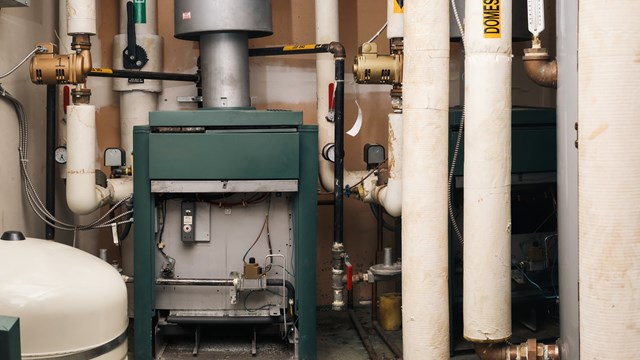Steam was once considered the lifeblood of Manhattan, providing heat to thousands of apartments and buildings. Even today, Con Edison provides steam for heat and hot water to approximately 1,800 buildings in New York City. However, upkeep and an aging infrastructure has made steam a more costly utility for many buildings. Kips Bay Towers in Murray Hill is one of many high rise apartment buildings in the city that recently reconsidered its dependence on centrally-supplied steam.
Built in 1961, the two 20-story Kips Bay Towers were designed by the famed architect I.M. Pei. Located practically next door to a Con Edison station, the facility’s use of central district steam at the time was a given—and also meant that neither building was ever properly equipped for an onsite boiler plant. Although the South Tower had been constructed with a chimney, it was never actually used. When the North Tower was built, the developer avoided the construction cost of the chimney altogether, assuming that the building would always rely on Con Edison to supply steam.
Central Steam Blues
For decades, the utility supplied the towers with high-pressure steam at 180 pound-force per square-inch gauge or (psig), which was used to provide hot water for both building heat and domestic water use. The steam had to go through two separate reduction stations to bring it down to the 10 psig required by the building’s mechanical equipment. Within each tower, this lower pressure steam was piped into a shell-and-tube heat exchanger (which transfers heat from the low-pressure steam) with a hot water coil for building heat. Downstream of this heat exchanger, three pneumatic zone valves controlled heating distribution to the three zones of each building. These valves were operated by a proprietary control system, which was very complex and difficult to service.
The system’s complexity and lack of serviceability weren’t the only problems. Large amounts of high-temperature condensation were generated, which had to be disposed of somehow. New York City regulations prohibit dumping water hotter than 149°F (65°C) into the sewer system. To lower the temperature of the water and avoid wasting the heat, this condensate was piped into a separate heat exchanger and used to preheat the cold water feeding the domestic hot water tanks in each building. This removed some—but not all—of the necessary heat from the condensate. Downstream, some degree of fresh street water had to be added to the condensate just so it could be dumped into the sewer. This, however, resulted in higher water and sewer fees that even now continue to escalate. These two factors prompted Kips Bay Towers’ administration to take action.
Making Room for a Solution
Cooper Square Realty, the property management group for Kips Bay Towers, began investigating the potential benefits of a conversion from centrally-supplied steam to an on-site boiler plant. Part of this investigation involved their eligibility for the New York Energy Smart Loan Fund Program, which offers reduced interest rate financing to building owners. Once Kips Bay Towers’ eligibility was confirmed, they sought the expertise of Ralph Germain of Robert F. Germain Engineering, a firm experienced in steam conversion projects in the New York City area.
“Typically, a building will save 50 percent in energy costs by converting from central steam to an in-house heat source,” says Germain. “The trick is finding space for the boilers and a way to locate a chimney.” Finding this space is difficult because thanks to the availability of steam, many of the buildings built in 20th century Manhattan were built without smokestacks or individual heating plants.
With the assistance of energy controls manufacturer Heat-Timer Inc., however, Germain found a solution that would give Kips Bay Towers some relief from high energy costs while also increasing their overall energy efficiency.
First, the two large cast iron domestic hot water tanks in each building’s basement were dismantled. These tanks had internal steam coils and were used to heat the domestic hot water for the towers. By opting for a new means for domestic hot water, Kips Bay was able to free up this space for two new boilers, designed to use natural gas as their primary fuel with oil as a backup. Both boilers make steam, although space heating in the apartments is all hydronic—meaning that the heat is transferred by water flowing through a closed system of pipes. This steam is piped directly into a shell-and-tube heat exchanger that’s rated for high water pressure, which is necessary in order to get water to the top floors of the building. According to Germain, a boiler rated for such high-pressure water would have been prohibitively expensive.
For domestic hot water, a coil was built in below the waterline in the steam boilers, which heated the street water piped into the coils. In the summer, a low-fire flame maintains enough heat in the boiler to heat the domestic hot water, but not enough to make steam when it is no longer needed for building heat.
Of course, both boilers in each tower had to be vented—and completing this portion of the conversion project required one-part luck, and one-part ingenuity.
The South Tower had been built with a chimney that could be used to vent the tower’s boilers. For the North tower, the project team decided to convert an existing trash compactor into a chimney. They were able to do this because they discovered that the chute was made of brick, having originally been built as an incinerator. Through a painstaking process, Abilene, Inc., a mechanical contractor, was able to line this incinerator shaft with 10-gauge steel, converting it to a suitable boiler stack for the building. The company also lined the South Tower’s chimney as a precautionary measure to prevent any deterioration of the brick and mortar that might occur as a result of condensation.
Getting it Under Control
The next step in the conversion process was tying the steam, hydronic, and domestic hot water systems for each building all together with a modern, effective, and reliable control system. This was accomplished by installing a programmable device to control operation of the two 300-horsepower boilers in both towers, modulating them to precisely meet system set-points based on load requirements. The device significantly increases the efficiency of system heat output because it anticipates the varying loads of the building and adjusts accordingly. The system also collects and stores data based on the reaction time of the system—so it is constantly working to match the boiler output to the current load conditions.
Because Kips Bay was originally designed as a three-zone system, three motorized valves were installed between the shell-and-tube heat exchanger to the hot water used to distribute heat to the baseboard radiation located throughout both buildings. These motorized valves are controlled by an online monitoring system that modulates the hot water valves, thus providing a more precise temperature.
On the domestic hot water side, Kips Bay has a new, more efficient (and more environmentally-friendly) system. As described above, domestic hot water is heated via a coil located inside the steam boiler. Downstream, this hot domestic water mixes with cold water via two two-inch tempering valves that are piped in parallel to provide sufficient volume for each of the towers’ more than 500 units. They mix hot and cold water accurately to provide a safe domestic hot water temperature of 135°F.
Although boiler operation is still required in the summer to provide domestic hot water, steam is not. Therefore another device controls the boiler burners during warmer months, maintaining a lower level flame to make hot water, but not steam. This set-point control functions simply as a modulating aquastat, with the same rate of change control intelligence as the cold-weather controller.
Remote Web-based Monitoring
All of Kips Bay Towers’ monitoring and modulation devices are controlled via a web-based management system that lets authorized building personnel monitor and adjust the entire boiler system remotely via the Internet. No special software or hardware is required, and the operator can access all the individual controls’ functions without having to be in the boiler room. He or she can also monitor virtually endless operation data within the system. The online monitoring feature can even be set up to send regular history reports via e-mail or text messaging. It can also send alarms to cell phones or pagers should the system drift outside of any of its prescribed parameters.
Like many other facilities, Kips Bay made use of Internet technology in integrating various wireless sensors located throughout the building. These sensors—which can be located virtually anywhere in the building—relay information back to the online monitoring system so operators can monitor space temperatures, water levels, oil tank levels, and more. It also provides a means of verification if a tenant continues to complain about the temperature inside their apartment.
The integration of multiple sensors and online monitoring not only makes Kips Bay Towers’ heating and cooling systems more manageable, it makes it more efficient, allowing operators to “tweak” the system in response to changing outdoor temperatures or other factors.
According to Germain, so far no one is disappointed with the savings this new boiler and control system has provided to the building. Prior to beginning the conversion project, he conducted a feasibility study which indicated that the project would save the owners $500,000 in energy a year. As it turns out, that estimate was too low.
“It was an extremely successful project from everyone’s perspective—from the board to the project management team,” said Keith Werny, senior vice president of Cooper Square Realty. According to Werny, Kips Bay Towers spent $600,000 less during the first heating season after the conversion than what had been budgeted for in the previous year. That level of savings, along with the Smart Loan Fund program, paid for the conversion project in only three years.
On top of the savings, comfort is up and complaints are down among residents, according to Rich Aguire, the building engineer at Kips Bay Towers. “It’s been a home run,” he says, noting that tenant complaints regarding building heat and hot water are all but non-existent these days. He also enjoys the “web browsing”—being able to monitor the system from home or anywhere else. “That’s the fun part,” says Aguire.
Trish Holder is a freelance writer and consultant specializing in the HVAC industry. Heat Timer, Inc., based in Fairfield, New Jersey, provided the case study for publication.







4 Comments
Leave a Comment